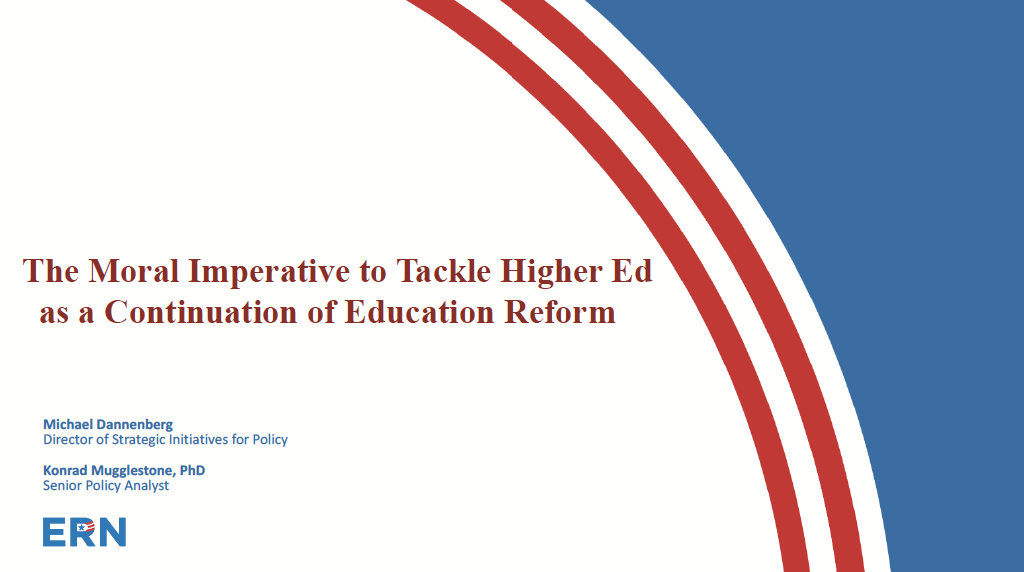by Michael Dannenberg and Konrad Mugglestone
Education reform advocates should recognize that extending their work to higher ed is a moral imperative that also happens to present a political opportunity.
Here’s a summary of our argument:
- Education reform will fail to deliver on its goals if we do not improve the quality of higher education access, overall affordability, and student outcomes.
- A high school diploma is not enough in today’s economy. Young people overwhelmingly recognize it, accordingly pursue higher education, and all too often experience dismal results.
- There rightfully has been a lot of attention to the failings of the for-profit postsecondary education sector, and its profound impact on young and older students alike. But the higher ed reform challenge extends much further.
- Three key stats:
- Over 75% of 18-25 year olds go on to postsecondary education. They may take time between high school exit and college entry, but they go. The vast, vast majority attend community colleges and public four-year institutions.
- Some 50% of all postsecondary students drop out. There are more college dropouts than high school dropouts. And those who drop out are four times more likely to default on a student loan.
- There’s new public data. Measured over a 12-year period from initial loan assumption, there is a near 50% Black borrower default rate. There is a 23% default rate for Black bachelor degree holders. Think about that. Twenty-three percent of bachelor degree holders. Public sector reliance on individuals taking out student loans to finance higher education is DEVASTATING Black, Brown, and low-income families.
- We need high schools to do a better job preparing students academically for postsecondary training. We need less reliance on student loans (i.e. increased college affordability). And we need colleges to do a better job.
- In the K-12 education system, we don’t see students as the problem, but institutions. In the higher education system though, we hold students responsible but not institutions. That needs to change. Both groups have power over outcomes.
- Some states and colleges do a good job or at least better than others. Some do a horrible job.
- Massachusetts has the 3rdsmallest white-Black public four-year college degree completion gap and the 37th worst white-Latino gap. Why? Because Massachusetts effectively channels talented Latino students into community colleges.
- Florida State and Michigan State have the same median SAT scores, same incoming student high school GPA, and yet generate wildly different results. At Florida State, there is no degree completion gap between white and under-represented minority students. At Michigan State, there is a 41 percent degree gap between white and Black students. Only 3 in 20 Michigan State Black males graduates on time. At Florida State, it’s three times higher.
- At the University of Akron, less than 20 percent of Black male students graduate within six years of initial enrollment. (Someone tell LeBron James, who not long ago pledged $41 million to the school.)
- Nationwide, nearly 100 four-year colleges have an overall six-year dropout rate above 80%.
- The good news is that as in K-12, there are proven strategies that work.
- We see it statewide in Tennessee, at Georgia State, Cal State-Fullerton, CUNY’s Lehman College, Fort Worth Community College, Portland, Oregon Community College, etc, etc…
- Every institution of higher education can improve on access, affordability, and success metrics for disaggregated subgroups, if not overall.
- It’s the same recipe for success as K-12: “resources and reform.” You can get some improvement with either alone, but you get maximum improvement with both.
- Progressives should make sure that ‘free’ college promises aren’t delivered by politicians on the cheap. Providing new, ‘last dollar’ tuition and fee scholarships as opposed to ‘first dollar’ grants to low-income students isn’t enough. Hard-pressed middle income and low-income families need a “debt-free” guarantee that extends beyond tuition and fees. Colleges need resources to improve student outcomes, and all should be held more responsible for results.
- Bottom line — Education advocates need to think of education reform as a K-16 challenge.
- Otherwise, K-12 education reform will fail to change many lives, and we’ll squander an opportunity to use the intense interest in college affordability to leverage change in K-12, specifically high schools.
The moral outrage that animates K-12 education reform needs to be brought to higher education. Now.
# # #
For those graphically inclined and looking for more detail, see our Powerpoint presentation here.
